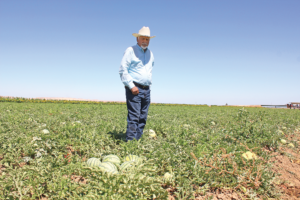Jul 28, 2023California melon growers applaud crop despite delay
California farmers say this season’s melon crop was delayed by about two weeks due to cool temperatures and wet fields, which affected early harvest of watermelons, cantaloupes and honeydews.
It postponed melon deliveries to supermarkets before Independence Day, a disappointing development for some growers.
“We missed the big marketing window for Fourth of July,” said Fresno County farmer Joe Del Bosque, a farmer, packer and shipper based in Firebaugh who grows organic cantaloupes, honeydews and watermelons and operates a fruit stand.
“To get fruit in the pipeline for Fourth of July, you really need to be harvesting by the 25th of June, which is a normal start for us,” Del Bosque said. “We were a little later than normal, but a lot of guys didn’t get started until about the 10th of July.”

In southern Fresno County, he said a late-season storm dampened some early melon fields and delayed harvest for growers near Huron. Some farmers reported challenges such as being unable to access fields and having to confront pest issues for early-season melons. The onset of warm temperatures dried things out and harvest resumed.
As the season continues, Del Bosque described the quality of melons as good and demand as steady. He said he hopes there is not “a bunching up” of melons hitting the market at once.
“If there is too much overlap, then we could get into a lot of volume, and that will impact the market,” he said.
Garrett Patricio, president of Westside Produce, a grower, packer and shipper of cantaloupes and honeydews based in Firebaugh, reported some overlap of harvest in the melon-growing regions, leading to more volume on the market, which affects price.
However, Patricio said, “For cantaloupes and honeydews, pricing has been good. We’re probably in the range of $9 to $10 per carton.”
The state’s melon season typically begins in the southern desert in April and goes through early July. It starts again in mid-October, running through early December. On the west side of the San Joaquin Valley, harvest usually runs from June to October.
Imperial Valley farmer Joe Colace of Five Crowns Marketing in Brawley grows, ships and packs melons, including cantaloupes and honeydews. He said the state’s melon crop is late, but quality is excellent.

“Everything looks above-average as far as sets and quality, and we’re anticipating a very high-quality crop throughout the season,” Colace said, noting that 40 acres of seedless watermelons he planted in the desert region were affected by cold weather early in the season.
After several years of drought, the state’s record snowpack and precipitation this year has been a plus for growers. Del Bosque, who receives water from the Westlands Water District, a federal Central Valley Project water contractor, said the district received a 100% water allocation. But he said growers did not learn the water allocation amount until after planting plans were made.
“We didn’t know at the start of the year what the allocation would be, so we planned for less than that,” Del Bosque said. “We got this extra water and you say, ‘I want to go out and plant some more,’ but you can’t get in the fields because of the late rain, so it was a little difficult to take advantage of all that water.”
A related benefit to plentiful water supplies, he said, is the lower cost of supplemental water transferred to the district compared to drought years.
“That (supplemental) water has been extremely, extremely expensive, but that’s all we’ve had for the last couple of years,” Del Bosque said.
Colace said he relied on surface water this year as opposed to groundwater.
“The good news is that you have state water, so farmers are not having to rely as much on pumping water or subsurface water,” Colace said. “This (surface water) is high-quality water, which really does produce a better-quality melon.”
Most of the state’s cantaloupe growers, who produce about 75% of the nation’s cantaloupes, have transitioned to varieties with a longer shelf life.
Faced with pressure from retailer customers and increasing labor costs, Patricio said, retailers required growers to plant longer-shelf-life varieties to lower the rate of rejected melons and reduce food waste. The newer varieties feature a harder exterior and firmer flesh, which means fewer passes by harvest crews and reduced costs, he said.
Patricio, who chairs the California Cantaloupe Advisory Board and serves on the California Melon Research Board, said he and some other shippers held off planting the new varieties because they felt melons grown with a requirement of 10% brix were not as flavorful as the traditional Western shipper varieties. In response, he said the California Cantaloupe Advisory Board instituted a higher standard of 12% brix to improve flavor for consumers.
“There will continue to be seed innovation, and I fully expect at some point in time we’ll have a hard-shell, low-food-waste cantaloupe that tastes fabulous,” Patricio said.
-Article courtesy California Farm Bureau’s Christine Souza

















